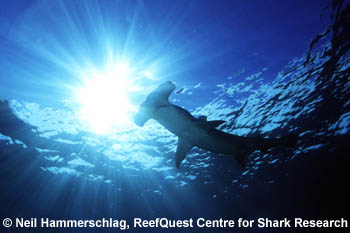Why Yet Another Shark Website?
Three Reasons:
1) I love sharks. Absolutely love them.
I think they're among the most beautiful, graceful, charismatic, fascinating, ancient and mysterious of all Earth's creatures. Some sharks have elegant lines and move with the liquid evenness of creatures perfectly at home with their place in the Universe. Others, by their spectacular and elusive natures, achieve fame and capture our collective imaginations in a way usually reserved for human celebrities. Biologically sharks are exquisite examples of evolutionary perfection, featuring adaptations of stunning sophistication and economical elegance. They inhabit an alien liquid universe in which they go about secret lives and enjoy a freedom we can only imagine. Sharks are also one of Nature's most durable success stories, having endured and flourished through at least 425 million years of profound environmental change. In a world in which there be no more dragons, sharks fill a deeply tribal need for an overwhelming primal force that - despite our technological artifice - puts our human frailty in stark perspective. Sharks are thus the perfect mythological beasts for our times.
2) There are no shark websites quite like this one.
Sure, there are a lot of shark-themed websites. And while many of them feature 'profiles' of a few of the most spectacular or well-known shark species, none really does justice to the full diversity of sharks, skates and rays (collectively termed 'elasmobranchs').
 Altogether, there are over 1,100 species of elasmobranchs, representing
an astonishing variety of forms and lifestyles. To me, the diversity of
sharks and their kin is far more fascinating than the relatively rare and
hugely overblown subject of shark attacks. Since no website on the
Internet surveys all known groups of elasmobranch and explains how they
are related to one another, it seemed there was a definite on-line 'gap'
that I could fill. After characterizing each group, I have included brief
profiles of some of its most interesting members. Taking full advantage of
'hotlinks', I have added some supplementary material that, where
appropriate and available, explores selected aspects of this or that
species or concept. I have also included some background material on how
sharks and rays are actually classified. In these ways, I hope to have
created a website that will serve a distinct need and one that you will
find interesting, informative, and useful.
Altogether, there are over 1,100 species of elasmobranchs, representing
an astonishing variety of forms and lifestyles. To me, the diversity of
sharks and their kin is far more fascinating than the relatively rare and
hugely overblown subject of shark attacks. Since no website on the
Internet surveys all known groups of elasmobranch and explains how they
are related to one another, it seemed there was a definite on-line 'gap'
that I could fill. After characterizing each group, I have included brief
profiles of some of its most interesting members. Taking full advantage of
'hotlinks', I have added some supplementary material that, where
appropriate and available, explores selected aspects of this or that
species or concept. I have also included some background material on how
sharks and rays are actually classified. In these ways, I hope to have
created a website that will serve a distinct need and one that you will
find interesting, informative, and useful.
3) Appreciating elasmobranch biodiversity is a
prerequisite for protecting it.
There are numerous websites advocating the protection of certain species - such as the celebrated Great White Shark (Carcharodon carcharias) - and decrying the appallingly cruel and wasteful practice of 'finning' (slicing off the fins most valued for soup, then unceremoniously discarding the rest of the animal - sometimes still alive, doomed to being torn asunder by other sharks or a slow death by starvation). There are even a few that passionately plea for a wide-scale adoption of a 'Save Our Sharks' ethic. But none of these websites takes the approach of conserving shark biodiversity as a whole.
A number of well-intentioned websites urge that shark conservation is extremely important because these top-level predators are absolutely vital to the ecology of the seas and many species are endangered. In truth, not all shark species are apex predators (many of the smaller species are preyed upon by a wide variety of marine creatures and thus function at significantly lower trophic levels) and we do not yet fully understand the role of sharks in ocean ecology (although we assume they play an important role, the nature and extent of their collective ecological roles, or that of any individual species, is far from clear). Further, there is no solid, scientific foundation for claiming that any species of shark is in danger of imminent extinction (while certain shark and ray populations seem to be greatly reduced regionally, their world-wide population size or the minimal genetic diversity needed to ensure any species' long-term survival are not known).
I care deeply about shark and ray conservation. Eventually, I plan to add to this website pages exploring the full complexity and subtlety of this issue, including things that 'ordinary' citizens can do to foster elasmobranch conservation. But to do justice to these topics will require a great deal of time and effort on my part and, at this writing, I am bogged down with other commitments until late 2002. Therefore, for the time being, I choose to use these pages to celebrate elasmobranch diversity for its own sake. It is my hope that - as others come to appreciate the wondrous variety of sharks and rays and the many ways they earn a living in their preferred habitats - these creatures will come to be valued as wildlife whose full diversity is worthy of study and protection.
If I can accomplish all these things, these pages will have a definite value, adding - in a positive and worthwhile way - to the total information content of the World Wide Web.
